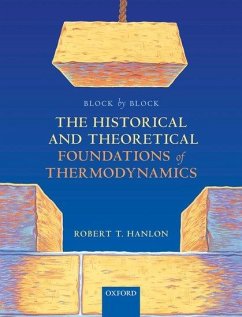Robert Hanlon
Block by Block: The Historical and Theoretical Foundations of Thermodynamics
Robert Hanlon
Block by Block: The Historical and Theoretical Foundations of Thermodynamics
- Gebundenes Buch
- Merkliste
- Auf die Merkliste
- Bewerten Bewerten
- Teilen
- Produkt teilen
- Produkterinnerung
- Produkterinnerung
In this text, the study of thermodynamics is manipulated against the normal course of study. While students and academics will learn the concepts, formulas, and laws of thermodynamics, they will also begin to understand the historical circumstance behind it all.
Andere Kunden interessierten sich auch für
![20th Century Physics: Essays and Recollections - A Selection of Historical Writings by Edoardo Amaldi 20th Century Physics: Essays and Recollections - A Selection of Historical Writings by Edoardo Amaldi]() 20th Century Physics: Essays and Recollections - A Selection of Historical Writings by Edoardo Amaldi301,99 €
20th Century Physics: Essays and Recollections - A Selection of Historical Writings by Edoardo Amaldi301,99 €![Historical Atlas of Crystallography Historical Atlas of Crystallography]() J. Lima-de-Faria (ed.)Historical Atlas of Crystallography92,99 €
J. Lima-de-Faria (ed.)Historical Atlas of Crystallography92,99 €![Science and Technology of the Undercooled Melt Science and Technology of the Undercooled Melt]() P.R. Sahm (ed.) / H. Jones / C.M. AdamScience and Technology of the Undercooled Melt112,99 €
P.R. Sahm (ed.) / H. Jones / C.M. AdamScience and Technology of the Undercooled Melt112,99 €![The Equations of Materials The Equations of Materials]() Brian CantorThe Equations of Materials118,99 €
Brian CantorThe Equations of Materials118,99 €![Lyotropic Liquid Crystals Lyotropic Liquid Crystals]() Ingo DierkingLyotropic Liquid Crystals149,99 €
Ingo DierkingLyotropic Liquid Crystals149,99 €![The Oxford Handbook of Soft Condensed Matter The Oxford Handbook of Soft Condensed Matter]() The Oxford Handbook of Soft Condensed Matter235,99 €
The Oxford Handbook of Soft Condensed Matter235,99 €![Foundations of Modern EPR Foundations of Modern EPR]() Gareth R EatonFoundations of Modern EPR163,99 €
Gareth R EatonFoundations of Modern EPR163,99 €-
-
-
In this text, the study of thermodynamics is manipulated against the normal course of study. While students and academics will learn the concepts, formulas, and laws of thermodynamics, they will also begin to understand the historical circumstance behind it all.
Hinweis: Dieser Artikel kann nur an eine deutsche Lieferadresse ausgeliefert werden.
Hinweis: Dieser Artikel kann nur an eine deutsche Lieferadresse ausgeliefert werden.
Produktdetails
- Produktdetails
- Verlag: Oxford University Press
- Seitenzahl: 672
- Erscheinungstermin: 16. Mai 2020
- Englisch
- Abmessung: 251mm x 198mm x 38mm
- Gewicht: 1565g
- ISBN-13: 9780198851547
- ISBN-10: 0198851545
- Artikelnr.: 58460010
- Herstellerkennzeichnung
- Libri GmbH
- Europaallee 1
- 36244 Bad Hersfeld
- gpsr@libri.de
- Verlag: Oxford University Press
- Seitenzahl: 672
- Erscheinungstermin: 16. Mai 2020
- Englisch
- Abmessung: 251mm x 198mm x 38mm
- Gewicht: 1565g
- ISBN-13: 9780198851547
- ISBN-10: 0198851545
- Artikelnr.: 58460010
- Herstellerkennzeichnung
- Libri GmbH
- Europaallee 1
- 36244 Bad Hersfeld
- gpsr@libri.de
Dr. Robert T. Hanlon earned his Sc.D. in chemical engineering from the Massachusetts Institute of Technology and subsequently conducted post-doctoral research at Karlsruhe University in Germany. His professional career took him to Mobil Oil Research & Development Corporation, the Rohm and Haas Company, and then back to MIT where he is currently involved with their School of Chemical Engineering Practice.
List of Figures
Introduction
Acknowledgements
Part I - The Big Bang (and the synthesis of the elements in stars)
1. The Big Bang: science
2. The Big Bang: discovery
Part II - The Atom (hard spheres that attract and repel each other)
3. The Atom: science
4. The Atom: discovery
Part III - Energy and the Conservation Laws
5. Energy: science (and some history)
6. Motion prior to Galileo
7. Galileo and the Law of Fall
8. Newton and the Laws of Motion
9. The lever
10. The rise of mv2
11. Bernoulli and Euler unite Newton and Leibniz
12. Rudimentary version of the conservation of mechanical energy (1750)
13. Heat: the missing piece to the puzzle
14. Joseph Black and the rise of heat capacity
15. Lavoisier and the birth of modern chemistry
16. Rise of the steam engine
17. Caloric theory: beginning of its end
18. The ideal gas
19. The final steps to energy and its conservation
20. Julius Robert Mayer
21. James Joule
22. The 1st Law of Thermodynamics
23. Epilogue: The mystery of beta decay
Part IV - Entropy and the Laws of Thermodynamics
24. Entropy: science (and some history)
25. It started with the piston
26. Britain and the steam engine
27. The Newcomen engine
28. James Watt
29. Trevithick, Woolf, and high-pressure steam
30. Sadi Carnot
31. Rudolf Clausius
32. William Thomson (Lord Kelvin)
33. The creation of thermodynamics
34. Clausius and the road to entropy
35. J. Willard Gibbs
36. Gibbs' 3rd paper
37. Practical applications and Gibbs energy (G)
38. Dissemination of Gibbs' work
39. The 2nd Law, entropy, and the chemists
40. Clausius: the kinetic theory of gases
41. Maxwell: the rise of statistical mechanics
42. Boltzmann: the probabilistic interpretation of entropy
43. Shannon: entropy and information theory
Afterword
Bibliography
Index
Epigraph Permissions
Introduction
Acknowledgements
Part I - The Big Bang (and the synthesis of the elements in stars)
1. The Big Bang: science
2. The Big Bang: discovery
Part II - The Atom (hard spheres that attract and repel each other)
3. The Atom: science
4. The Atom: discovery
Part III - Energy and the Conservation Laws
5. Energy: science (and some history)
6. Motion prior to Galileo
7. Galileo and the Law of Fall
8. Newton and the Laws of Motion
9. The lever
10. The rise of mv2
11. Bernoulli and Euler unite Newton and Leibniz
12. Rudimentary version of the conservation of mechanical energy (1750)
13. Heat: the missing piece to the puzzle
14. Joseph Black and the rise of heat capacity
15. Lavoisier and the birth of modern chemistry
16. Rise of the steam engine
17. Caloric theory: beginning of its end
18. The ideal gas
19. The final steps to energy and its conservation
20. Julius Robert Mayer
21. James Joule
22. The 1st Law of Thermodynamics
23. Epilogue: The mystery of beta decay
Part IV - Entropy and the Laws of Thermodynamics
24. Entropy: science (and some history)
25. It started with the piston
26. Britain and the steam engine
27. The Newcomen engine
28. James Watt
29. Trevithick, Woolf, and high-pressure steam
30. Sadi Carnot
31. Rudolf Clausius
32. William Thomson (Lord Kelvin)
33. The creation of thermodynamics
34. Clausius and the road to entropy
35. J. Willard Gibbs
36. Gibbs' 3rd paper
37. Practical applications and Gibbs energy (G)
38. Dissemination of Gibbs' work
39. The 2nd Law, entropy, and the chemists
40. Clausius: the kinetic theory of gases
41. Maxwell: the rise of statistical mechanics
42. Boltzmann: the probabilistic interpretation of entropy
43. Shannon: entropy and information theory
Afterword
Bibliography
Index
Epigraph Permissions
List of Figures
Introduction
Acknowledgements
Part I - The Big Bang (and the synthesis of the elements in stars)
1. The Big Bang: science
2. The Big Bang: discovery
Part II - The Atom (hard spheres that attract and repel each other)
3. The Atom: science
4. The Atom: discovery
Part III - Energy and the Conservation Laws
5. Energy: science (and some history)
6. Motion prior to Galileo
7. Galileo and the Law of Fall
8. Newton and the Laws of Motion
9. The lever
10. The rise of mv2
11. Bernoulli and Euler unite Newton and Leibniz
12. Rudimentary version of the conservation of mechanical energy (1750)
13. Heat: the missing piece to the puzzle
14. Joseph Black and the rise of heat capacity
15. Lavoisier and the birth of modern chemistry
16. Rise of the steam engine
17. Caloric theory: beginning of its end
18. The ideal gas
19. The final steps to energy and its conservation
20. Julius Robert Mayer
21. James Joule
22. The 1st Law of Thermodynamics
23. Epilogue: The mystery of beta decay
Part IV - Entropy and the Laws of Thermodynamics
24. Entropy: science (and some history)
25. It started with the piston
26. Britain and the steam engine
27. The Newcomen engine
28. James Watt
29. Trevithick, Woolf, and high-pressure steam
30. Sadi Carnot
31. Rudolf Clausius
32. William Thomson (Lord Kelvin)
33. The creation of thermodynamics
34. Clausius and the road to entropy
35. J. Willard Gibbs
36. Gibbs' 3rd paper
37. Practical applications and Gibbs energy (G)
38. Dissemination of Gibbs' work
39. The 2nd Law, entropy, and the chemists
40. Clausius: the kinetic theory of gases
41. Maxwell: the rise of statistical mechanics
42. Boltzmann: the probabilistic interpretation of entropy
43. Shannon: entropy and information theory
Afterword
Bibliography
Index
Epigraph Permissions
Introduction
Acknowledgements
Part I - The Big Bang (and the synthesis of the elements in stars)
1. The Big Bang: science
2. The Big Bang: discovery
Part II - The Atom (hard spheres that attract and repel each other)
3. The Atom: science
4. The Atom: discovery
Part III - Energy and the Conservation Laws
5. Energy: science (and some history)
6. Motion prior to Galileo
7. Galileo and the Law of Fall
8. Newton and the Laws of Motion
9. The lever
10. The rise of mv2
11. Bernoulli and Euler unite Newton and Leibniz
12. Rudimentary version of the conservation of mechanical energy (1750)
13. Heat: the missing piece to the puzzle
14. Joseph Black and the rise of heat capacity
15. Lavoisier and the birth of modern chemistry
16. Rise of the steam engine
17. Caloric theory: beginning of its end
18. The ideal gas
19. The final steps to energy and its conservation
20. Julius Robert Mayer
21. James Joule
22. The 1st Law of Thermodynamics
23. Epilogue: The mystery of beta decay
Part IV - Entropy and the Laws of Thermodynamics
24. Entropy: science (and some history)
25. It started with the piston
26. Britain and the steam engine
27. The Newcomen engine
28. James Watt
29. Trevithick, Woolf, and high-pressure steam
30. Sadi Carnot
31. Rudolf Clausius
32. William Thomson (Lord Kelvin)
33. The creation of thermodynamics
34. Clausius and the road to entropy
35. J. Willard Gibbs
36. Gibbs' 3rd paper
37. Practical applications and Gibbs energy (G)
38. Dissemination of Gibbs' work
39. The 2nd Law, entropy, and the chemists
40. Clausius: the kinetic theory of gases
41. Maxwell: the rise of statistical mechanics
42. Boltzmann: the probabilistic interpretation of entropy
43. Shannon: entropy and information theory
Afterword
Bibliography
Index
Epigraph Permissions








